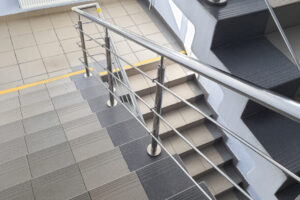Blog
- Home
- Resources
- Bright Ideas Blog
- Lighting Guidelines and Regulations at Your Commercial Property
Lighting Guidelines and Regulations at Your Commercial Property

There are many building codes, electrical codes, and emergency standards outlined by the Americans with Disabilities Act (ADA), National Fire Protection Association (NFPA), International Building Code (IBC), Occupational Safety and Health Administration (OSHA), state and local regulations, and others that provide lighting guidelines and requirements for commercial and similar properties. These include for interior lighting, exterior lighting, and emergency lighting.
Property owners and managers must comply with these regulations in order to avoid legal penalties and fines. There are some exceptions, such as for historical buildings or certain types of space (like retail or offices), and individual states or municipalities can also have different regulations based on the area.
Read on for a summary of the guidelines and regulations you should adhere to at your commercial property. As mentioned, this list serves as a summary. It’s always important to keep informed of changes or any regulations specific to your property and geographic location.
ADA Lighting Regulations
The Americans with Disabilities Act became law in 1990. At its most basic, the ADA is a civil rights law that prohibits discrimination against individuals with disabilities in several areas including:
- Employment
- Transportation
- Public accommodations
- Communications
- Access to certain programs and services
The ADA also focuses on many design issues and concerns, from steps and walkways to windows and lighting.
The 2010 ADA Standards for Accessible Design outlines some regulations for indoor and exterior light fixtures, highlighting the importance of any public spaces and commercial buildings ensuring hallways, bathrooms, and other areas can be accessed by everyone.
Some of these regulations include:
- Guidance around “protruding objects,” which includes anything that sticks out from walls, doors, or ceilings. For example:
- Wall-mounted luminaries (including sconces) are limited to four inches in depth when located between 27 inches and 84 inches from the finished floor level of walks, halls, corridors, passageways, or aisles. If mounted higher than 84 inches from a finished floor, they can be greater than 4 inches in depth.
Wall-mounted guidelines are especially important in bathrooms as they allow more room for bath vanities, sinks, and grab bars. Find a wide variety of ADA-compliant styles and colors to choose from.
- Light switches must be located no higher than 48 inches above the ground with no obstructions and nothing in the way of knees or toes.
- Overhead lighting guidelines state any ceiling lighting, like chandeliers and pendant lights, shouldn’t go lower than the minimum head clearance, which is 80 inches.
- Signs must be legible for persons with low vision. Specifically, avoid lighting that casts shadows or creates glare on signs, including in bathrooms and elevators.
Interior Lighting
Outside of ADA regulations, there are other codes and guidance for interior lighting, including direct and indirect lighting, down and up lighting, and wall- or floor-mounted fixtures. For example:
- ASHRAE and IECC mandate that enclosed spaces should have at least one control device that independently controls general lighting in the space (such as switches, sensors, or timers).
- According to the Lightng Control Association, typically, lighting must be turned off when not in use.
- Due to EPA-mandated manufacturing standards, most incandescent and fluorescent lighting will no longer be produced. This will require commercial properties to replace their fixtures and bulbs. LED lighting is the most energy-efficient lighting today, lasting longer and saving money long-term.
- According to the NFPA, new stairwell light levels must be no less than 10 fc measured on the floor when in use.
Exterior Lighting
The latest commercial building energy codes and standards outline guidelines for exterior lighting, including ways to help save energy, extend the product life, and maintain a secure environment. These often require input/output devices/systems to control lighting, including switches, sensors, or a combination of both.
In general, exterior lighting:
- Must be maintained and in good working order at all times.
- Should be designed to avoid harsh contrasts in lighting levels.
- Should be directed downward and not have bulbs or reflectors that project below the bottom rim of the fixture to help ensure maximum effectiveness.
Many local codes also have regulations around lighting near property lines or in residential zones. For example, if the lighting is within a certain distance from a residential zone, it may have to be a certain height above ground or directed a certain way to avoid direct illumination on the adjacent residential zones.
There are also a number of regulations around lighting in parking lots and garages. Examples can include:
- Open-air parking lot lights should provide sufficient lighting to:
- Light walkways
- Reduce shadows
- Reveal tripping hazards
- Deter trespassers
- Limit light pollution
- Optimize energy use
- Time and occupancy sensor-based lighting with reduction controls is preferred. Lighting should remain on at all times but can be reduced by 30% when unoccupied.
- Depending on the lot size and use, consider 15–20-foot light poles, 20-25-foot light poles, or 25-35-foot “high mast” poles.
Emergency Lighting
Most building codes also outline regulations around emergency lighting to ensure the safety of occupants. In general:
- Commercial and residential properties, such as apartment buildings, are required to illuminate areas when something goes wrong, like a fire.
- Commercial buildings must have emergency and exit-path lighting to illuminate and identify hallways, stairwells, and exits. Emergency lighting must emit at least 1.07 lux of light along the emergency exit path at floor level.
- If a building does not have a centralized inverter or backup generator, emergency lighting must still be distributed, requiring dedicated emergency lights or battery-backup LED drivers in certain fixtures.
- Emergency lights must remain illuminated for a certain period of time, such as 90 minutes.
There are also specific regulations around exit signs:
- Exit signs must be illuminated to a surface value of at least 54 lux (five foot-candles) and be distinctive in color.
- The signs must be located so that no point in an exit access corridor is more than the sign’s rated viewing distance, or 100 feet from the nearest sign.
- Signs with directional indicators must be placed in every location where the direction of travel is not apparent.
- There can be no brightly illuminated sign, display, or object near the line of vision of the required sign that could distract attention.
- The sign must be legible in both normal and emergency lighting
Because emergency lighting is so important for safety, there are also some recommendations around how to ensure emergency lighting is always functional.
For example, an emergency power source should take over standalone emergency lighting if power is lost, especially in hallways and stairwells. Fixtures that are powered by emergency power should only be off when normal power is present. However, this is often less energy-efficient, has little flexibility, and requires regular battery maintenance and replacement.
You can also use general-purpose fixtures designated as emergency fixtures, requiring an emergency LED driver with a battery. The downside to this is that these are only meant to provide enough illumination to satisfy required footcandle levels for egress.
The most flexible and cost-effective option is a centralized lighting control system. This is one piece of equipment that senses and activates emergency lighting for large parts of or the entire lighting system. This requires using a centralized emergency power source but has no need for dedicated emergency fixtures or battery maintenance. It can also be easily configured via software (including what lights are activated and the light levels).
Work with Bay Lighting
If you are in need of quality commercial lighting solutions in Maryland, D.C., or Virginia, contact Bay Lighting. We offer expert lighting installation services at the most affordable rates in the area. Contact us today to get started, or call (301) 858-9494.




